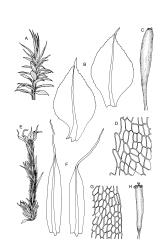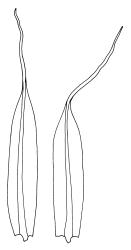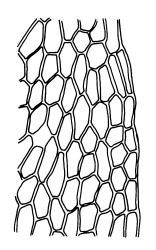- ≡ Splachnum octoblepharum Hook., Musci Exot. 2, 167 (1819)
- ≡ Eremodon octoblepharis (Hook.) Hook.f. & Wilson, Bot. Antarct. Voy. II (Fl. Nov.-Zel.) Part II, 94 (1854)
- = Splachnum octoblepharum var. major Hook.f. & Wilson, Bot. Antarct. Voy. I. (Fl. Antarct.) Part I, 124 (1845)
- ≡ Tayloria octoblepharum var. major (Hook.f. & Wilson) Watts & Whitel., Proc. Linn. Soc. New South Wales 30 (Supplement): 108 (1906)
- = Splachnum plagiopus Mont., Ann. Sci. Nat., Bot. sér. 3, 4: 121 (1845)
- ≡ Dissodon plagiopus (Mont.) Müll.Hal., Syn. Musc. Frond. 2, 551 (1851)
- = Splachnum octoblepharum var. pyriforme Hook.f. & Wilson, Bot. Antarct. Voy. I. (Fl. Antarct.) Part I, 123 (1845)
Plants medium to robust, bright green to golden-green, pink below; rarely dirty brown throughout. Stems usually unbranched, pink, (7–)10–15(–25) mm, beset with purple-brown, smooth rhizoids. Leaves spreading when moist, moderately crisped and ± ridged (due to abaxially protruding costa) when dry, narrowly obovate to ± elliptic (but widest above middle), gradually tapered to a long, slender, golden arista (to 2 mm and sometimes >½ the total leaf length), entire, recurved to ± revolute at margins, 3.0–4.5 × 0.8–1.5(–2.5) mm; upper laminal cells firm-walled, oblong-hexagonal, 45–60(–75) μm, slightly larger near costa, scarcely differentiated at margins, becoming longer (to c. 180 μm) and more regularly oblong towards base. Costa pink at base, becoming concolourous with lamina above, 100–120 μm wide at ⅓ above leaf base, extending into the base of the arista and excurrent, strongly protruding abaxially, in cross-section lacking stereids. Axillary hairs inconspicuous.
Dioicous. Perichaetial leaves not differentiated. Perigonia terminal, but often overtopped by innovation and several per plant, ± globose, with bracts weakly differentiated, ovate-lanceolate, erect spreading, with numerous 4–5-celled filiform paraphyses. Setae 3–14 mm, straight (rarely flexuous), smooth, variable (200–350 μm) in diameter, scarcely twisted when dry, pale brown; capsules erect or inclined, symmetric or somewhat asymmetric due to curvature of neck, with a short cylindric to obovoid urn and a well-developed neck ½ –⅔ (–¾) the total capsule length, (2.0–)2.5–5.0(–8.0) mm, smooth, dirty green-brown when fresh, becoming dark brown or black on drying; exothecial cells ± isodiametric, thick-walled (occasionally thicker at corners), c. 25 rows oblate below mouth; stomata few, columella protruding beyond mouth when dry; annulus weakly differentiated, falling with operculum; operculum as per genus. Peristome teeth inserted below the mouth, recurved when dry, orange to pale yellow-brown, longitudinally fused to form eight broadly triangular compound teeth, extending c. 225–275 μm beyond the mouth, c. 150–180 μm wide, finely papillose-baculate on outer surface; preperistome present as papillose fragments. Calyptra as per genus, becoming split up one side with age, c. 1.0 mm. Spores ± globose, 12–15 μm, smooth.
Wilson & Hooker 1845, tab. LVII, fig. iv (as Splachnum octoblepharum); Goffinet 2006, fig. 17, h–k; Seppelt et al. 2013, pl. 35.
NI: N Auckland, including offshore islands (GB), S Auckland, Gisborne, Hawke's Bay, Wellington; SI: Marlborough, Canterbury, Westland (Kelly Range, Paparoa Range), Otago, Southland; St; Ch; A; C; M.
Australasian. Tasmania*, mainland Australia*, Chile*.
On dung of various animals (deer, horse, cow, pig), decayed carcasses, humus or peat, rotten wood, and tree fern stumps in coastal, tussock, scrub or forest habitats. Ranging from near sea level to c. 1400 m on both main islands. Tayloria octoblepharum often grows mixed with T. purpurascens.
Tayloria octoblepharum is exceedingly variable with respect to stature, including seta and capsule length, and, to lesser extent, the amount of swelling of the urn. This variability has resulted in several published names. The golden aristae composed of the usually long excurrent costae, the narrow, entire leaves, and the striking salmon-pink colouration of the lower costae and stems facilitate recognition both in the field and herbarium. Bright purple pigmentation occurs, with only very rare exceptions, only in the rhizoids, in contrast to T. purpurascens where the pigments are also deposited in laminal cell walls. The tendency of the capsule urn to blacken before the neck also facilitates recognition of T. octoblepharum. When fresh the mature capsules are a dirty green-brown, but the greenish hue fades and the capsules become darker upon drying; they emit a rank and powerful, unpleasant odour.
According to Anne Gaskett (pers. comm. Feb. 2015), in south-western Tasmania T. octoblepharum capsules produce odours mimicking those normally produced by rotting vegetation/herbivore dung (indoles, cresols, and phenols) and attract flies belonging predominantly to the families Heleomyzidae and Muscidae.
Plants with dark brown pigmentation, and wider than typical leaves (rarely to 2.5 mm) occur rarely, and are perhaps associated with very wet environments. Such plants often show transition to a more typical morphology in their upper parts.
A unusual substrate has been noted for this species in Tasmania where one mid-19th century collection (seen in BM) was made from "the Bones & decayed clothing of a Bushranger, at the base of the Western Mountains, with two double-barrelled Guns & Pistols lying by his side".








